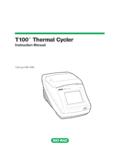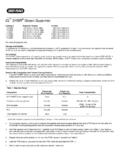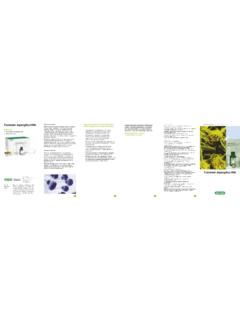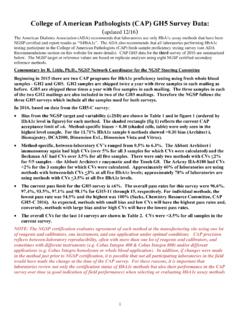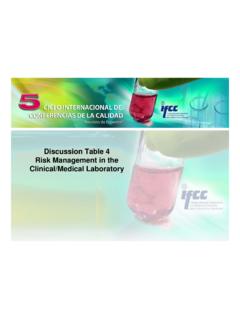Transcription of RNA integrity and the effect on the real-time qRT …
1 ReviewRNA integrity and the effect on the real-timeqRT-PCR performanceSimone Fleigea, Michael W. Pfaffla,b,*aPhysiology Weihenstephan, Center of Life and Food Sciences (ZIEL),Technical University of Munich, 85350 Freising, GermanybTATAA Biocenter Germany, Freising-Weihenstephan, GermanyAbstractThe assessment of RNA integrity is a critical first step in obtaining meaningful gene expres-sion data. Working with low-quality RNA may strongly compromise the experimental resultsof downstream applications which are often labour-intensive, time-consuming, and highlyexpensive. Using intact RNA is a key element for the successful application of modern mole-cular biological methods, like qRT-PCR or micro-array analysis. To verify RNA quality now-adays commercially available automated capillary-electrophoresis systems are available whichare on the way to become the standard in RNA quality assessment.
2 Profiles generated yieldinformation on RNA concentration, allow a visual inspection of RNA integrity , and generateapproximated ratios between the mass of ribosomal sub-units. In this review, the importanceof RNA quality for the qRT-PCR was analyzed by determining the RNA quality of differentbovine tissues and cell culture. Independent analysis systems are described and compared (ODmeasurement, NanoDrop, Bioanalyzer 2100 and Experion). Advantage and disadvantages ofRNA quantity and quality assessment are shown in performed applications of various tissuesand cell cultures. Further the comparison and correlation between the total RNA integrity onPCR performance as well as on PCR efficiency is described. On the basis of the derived resultswe can argue that qRT-PCR performance is affected by the RNA integrity and PCR efficiencyin general is not affected by the RNA integrity .
3 We can recommend a RIN higher than five as0098-2997/$ - see front matter 2005 Elsevier Ltd. All rights *Corresponding author. Present address: Physiology Weihenstephan, Center of Life and Food Sciences(ZIEL), Technical University of Munich, 85350 Freising, Germany. Tel.: +49 8161 71 3511; fax: +49 816171 Pfaffl).Molecular Aspects of Medicine 27 (2006) 126 total RNA quality and higher than eight as perfect total RNA for downstreamapplication. 2005 Elsevier Ltd. All rights :RNA quality; RNA quantity; qRT-PCR; 2100 Bioanalyzer; Experion; Lab-on-chipContents1. The particular importance of RNA quality .. RNA extraction .. RNA quantity and quality assessment .. 1292. integrity of RNA and its effect on real-time qRT-PCR .. General aspects.. Effect on the mRNA quantification.
4 Association between RNA quality and length of the amplified product .. 1363. Conclusion .. 137 References .. 1371. The particular importance of RNA IntroductionThe accuracy of gene expression evaluation is recognised to be influenced by thequantity and quality of starting RNA. Purity and integrity of RNA are criticalelements for the overall success of RNA-based analyses. Starting with low qualityRNA may strongly compromise the results of downstream applications which areoften labour-intensive, time-consuming and highly expensive (Raeymarkers, 1993;Imbeaud et al., 2005). It is preferable to use high-quality intact RNA as a startingpoint in molecular biological as well as in diagnostic applications. Especially inquantitative RT-PCR, micro-arrays, ribonuclease-protection-assay, in situ hybrid-ization, northern blot analysis, RNA mapping, in vitro translation, cDNA libraryconstruction and any kind of array applications the integrity of the used totalRNA should be checked.
5 Especially in clinical application with unique or limited tis-sue material, obtained after surgery, a reliable RNA quality analysis is necessary(Bustin and Nolan, 2004b). As a consequence, several steps during tissue handlinghave to be carefully controlled in order to preserve the quality and integrity of theRNA material. It is well known that RNA is sensitive to degradation by postmortemprocesses and inadequate sample handling or storage (Perez-Novo et al., 2005). Thusthe competency to quickly assess RNA quality using minor amounts has becomeincreasingly important as the following measures of mRNA transcripts have becomemore expensive and more Fleige, Pfaffl / Molecular Aspects of Medicine 27 (2006) 126 RNA extractionThe quality and quality of purified RNA is variable and after the extraction dur-ing long storage rather unstable (Bustin et al.)
6 , 2005). Especially long mRNA frag-ments up to 10 kb are very sensitive to degradation. This can happen throughcleavage of RNAses introduced by handling with RNA samples. The most obviousproblem concerns the degradation of the RNA and this is best addressed by insistingthat every RNA preparation is rigorously assessed for quality and quantity. Theextraction and purification procedure of total RNA must fulfill the following criteria(Bustin and Nolan, 2004b; Pfaffl, 2005a): free of protein (absorbance 260 nm/280 nm); free of genomic DNA; should be undegraded (28S:18S ratio should be roughly between and , withlow amount of short fragments); free of enzymatic inhibitors for RT and PCR reaction, which is strongly depen-dent on the purification and clean-up methods; free of any substances which complex essential reaction co-factors, like Mg2+orMn2+; free of nucleases for extended storage;There are a substantial quantity of problems that affect reproducibility, and hencethe relevance of results.
7 The source of RNA, sampling techniques (biopsy material,single cell sampling, laser micro-dissection) as well as RNA isolation techniques(either total RNA or poly-adenylated RNA isolation techniques) often vary signifi-cantly between processing laboratories (Bustin and Nolan, 2004b; Pfaffl, 2004). TheRNA quality can be different between two extraction methods, performed byhand or by an automatic extraction system. The isolated total cellular RNA withthe liquid extraction, Trizol (Roche Diagnostics, Germany) or TriFast (peqlab,Germany), has different RNA quality, whereas only the type of homogenization ischanged (Fleige and Pfaffl, 2006). Due to its inherent susceptibility to ubiquitousRNases and its chemical instability, RNA is readily endangered by base- orenzyme-catalyzed hydrolysis.
8 Researchers must take into account a variety offactors, which influence their ability to obtain high-quality RNA that is free of con-tamination such as RNases, proteins and genomic DNA. These factors include yieldvariations, processing requirements, and sample availability of different cells ortissues. The best RNA yield is obtained from tissue that has been diced into smallfragments with a scalpel prior to being frozen by submerging in liquid samples must be homogenized using a bead mill or a mechanical homogenizer(Bustin and Nolan, 2004b).Further problem may arise in the case of research on human or animal tissue sam-pling techniques and the time dependency until the tissue is stored safely in RNaseinhibitors or RNA-later (Ambion, USA). It is often very challenging to decrease thissampling time to a minimum within the framework of clinical routine procedures, orin animal experiments during a slaughtering process.
9 The RNA quality may also be128S. Fleige, Pfaffl / Molecular Aspects of Medicine 27 (2006) 126 139impaired in samples stored for a long time or under sub-optimal conditions (Schooret al., 2003). RNA quantity and quality assessmentConventional methods are often not sensitive enough, not specific for single-stranded RNA, and disposed to interferences from contaminants present in thesample (Imbeaud et al., 2005). The assessment of RNA integrity can do by variousmethods: the classical gel OD measurement, modern OD measurement via Nano-Drop, old fashioned denaturating agarose gel-electrophoresis or with high innova-tive lab-on-chip technologies like Bioanalyzer 2100 (Agilent Technologies, USA)and Experion (Bio-Rad Laboratories, USA). Quantity and quality assessment usinga UV/VIS spectrophotometer should be performed at multiple wave lengths at240 nm (background absorption and possible contaminations), 260 nm (specific fornucleic acids), 280 nm (specific for proteins), and 320 nm (background absorptionand possible contaminations).
10 On basis of the OD 260 the quantity, and by the ratioof the optical density (OD) of OD 260/280 the quality, OD 260/240 or OD 260/320the purity and the extraction performance can be verified. An OD 260/280 ratiogreater than is usually considered an acceptable indicator of good RNA quality(Sambrook et al., 1989; Manchester, 1996). By the presence of genomic DNA theOD 260 measurement can compromised and leading to over-estimation of the actualand real RNA concentration. Further the used buffer and high salt concentrationswill interfere with the result of the optical measurement and therefore the calculatedRNA concentrations might be over- or under-estimated (own unpublished results).The accuracy of the OD 260/A280 method has been questioned, with a value corresponding to only 40% RNA, with the remainder accounted for by protein(Bustin and Nolan, 2004b).


